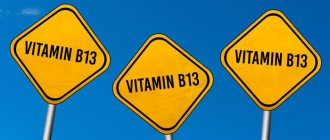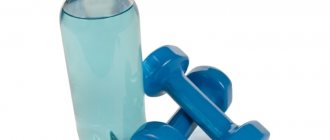For coordinated work, the body needs biologically active substances coming from outside. These include vitamins, vitamin-like compounds and minerals. Vitamin B6 (another name is pyridoxine) belongs to group B and has many beneficial effects. The nutrient is formed in small quantities in the large intestine, but is not absorbed from there, so it is necessary to ensure sufficient supply of the substance from the outside. The vitamin is actively used in medicine for the treatment and prevention of various diseases, cosmetology, sports and bodybuilding. You can get detailed information about the benefits and harms of the nutrient, signs of hypovitaminosis and hypervitaminosis, and the best food supplements with B6 in our article.
Now Foods, B6, 50 mg, 100 tablets
from 353 ₽
More details
General information
The history of the discovery of the substance, which is now called pyridoxine, begins in 1934, and is associated with the name of the Hungarian doctor P. Giorgi. This doctor studied the manifestations of dermatitis in rats, and noticed that the disease disappeared under the influence of a certain substance, which he called vitamin B6. Four years later, S. Lepkowski was able to obtain the compound by processing yeast. In 1939, scientists in the field of biochemistry established the exact structure and chemical formula of the active compound.
The name vitamin B6 refers to a mixture of 3 chemical compounds with similar effects on the body - pyridoxal, pyridoxole and pyridoxamine. Later, the positive effects of the substance were established not only for dermatological problems, but also for diseases of the nervous system. The substance has received good reviews from doctors and is now widely used in medicine.
Release forms
Chemical analogues of the vitamin were obtained synthetically:
- Pyridoxal phosphate - available in film-coated tablets of 0.01 and 0.02 g;
- Pyridoxine hydrochloride – tablets of 0.002, 0.005, 0.01 g, ampoules of 1 ml of 1% and 5% solution.
Pyridoxine hydrochloride passes through cell membranes more easily than pyridoxal phosphate and quickly enters the brain from the blood. But if the patient has liver pathology, a lack of zinc, magnesium, pyridoxal phosphate is preferable.
Is it possible to drink vitamin B6 from ampoules?
You can often hear suggestions in fashionable women's magazines to drink Adermin directly from ampoules. Some advise drinking without even diluting with water. The meaning of these recommendations is unclear.
The composition of the ampoule substance is designed for absorption of the vitamin through the blood. This ensures its rapid entry into the body, especially in case of intestinal poisoning, toxicosis in women, accompanied by vomiting and diarrhea.
Pyridoxine is prescribed in ampoules to patients with ulcerative lesions of the digestive system to prevent its contact with acidic gastric juice.
By drinking the concentrate from the ampoule, a person can cause a burn to the mucous membranes and stomach and a violent allergic reaction. And an unprotected substance, having passed through the digestive tract, will lose its activity
How to take the pills
Tablets, especially those protected by a shell (capsule), are designed to pass through the hostile environment of the digestive tract, without loss of beneficial properties.
They should be taken between meals or with food. It is better to divide the daily dose into equal parts.
A large dose of pyridoxine should be taken in the morning by people suffering from sleep disorders. When taking pyridoxine, you need to remember its compatibility with other vitamins and macroelements.
Table 5. Pyridoxine interactions
| Compatible | Incompatible | Enhances the effect | Reduces the effect of pyridoxine |
| Riboflavin (Vitamin B2) | Thiamine (Vitamin B1) | Diuretics | Penicillamine |
| Niacin (Vitamin PP) | Cyanocobalamin (Vitamin B12) | Cycloserine | |
| Vitamin D | Caffeine | Mercaptopurine | |
| Folic Acid (Vitamin B9) | Eufillin | Isoniazid | |
| Mg (Magnesium) | |||
| Ca (Calcium) | Ethionamide | ||
| Zn (Zinc) | Immunosuppressants | ||
| Glutamic acid | Estrogens | ||
| Aspartame |
Reference! Activated carbon interferes with the absorption of vitamins.
Physico-chemical features
According to the chemical structural formula, the substance is a six-membered heterocycle with a nitrogen atom, to which various active groups are attached: amine, alcohol, aldehyde.
Pyridoxine B6 compounds are highly soluble in water and practically do not react with alcohols. Macroscopically, the nutrient is a whitish, finely crystalline powder that is odorless. The vitamin has the property of being quickly destroyed when exposed to ultraviolet rays. The beneficial properties of vitamin B6 for the human body are due to its ability to be converted into a more active form called pyridoxal phosphate. The substance in the form of a cofactor helps in various metabolic processes of decarboxylation and transamination of amino acids, fat metabolism, it is capable of changing the biochemistry of many processes in the body.
Name options
Vitamin B6 is a group of organic natural compounds, distinguished by the presence of groups in their structure:
- Alcohol – pyridoxine ;
- Aldehyde – pyridoxal ;
- Amino groups - pyridoxamine .
In the human body, vitamin B6 is found in 80% of cases in the form of the last two substances presented in the list.
The substance was discovered at the beginning of the twentieth century as a component of plant and meat products. Part of pyridoxine is produced by intestinal microflora.
Vitamin derivatives are coenzymes (coenzymes), without which enzymes cannot start. These are proteins that catalyze chemical reactions in cells. Pyridoxal phosphate is a taxi for some amino acids across cell membranes.
Pyridoxine - what kind of vitamin is it?
Structural formula of pyridoxine
Scientists decided to classify a group of active substances with similar hydrophilic and coenzyme properties as water-soluble vitamins. The main name of the group is pyridoxine or vitamin B6. But variant names can be used - adermin, antidermatitis.
The natural vitamin is not destroyed during heat treatment of foods. Canning kills pyridoxine.
Pyridoxine hydrochloride, what kind of vitamin is it?
The forties of the twentieth century were marked by the production of a chemical analogue of the vitamin synthetically, in order to compensate for its deficiency - pyridoxine hydrochloride.
Several methods have been proposed for obtaining this medicine. But the method for the synthesis of pyridoxine hydrochloride, proposed by S. Harris and Volkers, was recognized as the cheapest and simplest in technology.
The method boils down to obtaining an intermediate product - “ pyridone ” by nitration of monochloroacetic acid and the complex interaction of sodium salts and acetone derivatives using special equipment. The resulting semi-finished product is used to obtain technical pidoxidine hydrochloride.
The medical form is obtained by adding ethanol and activated carbon to technical pyridoxine and subsequent filtration, evaporation, crystallization, and drying.
Medical pyridoxine hydrochloride is white crystals. They melt and decompose at a temperature of 204 - 206°C. The substance is highly soluble in water and chloroform.
Acetone and alcohol are practically insoluble. Ether has no effect on him. It is resistant to acidic and alkaline solutions, but loses its beneficial properties by 30%. Instantly decomposes when exposed to sunlight.
Biological role
The main pharmacological effects of vitamin B6 (pyridoxine) are:
- Participation as a coenzyme in all reactions of protein metabolism, transformation and breakdown of amino acids.
- Acceleration of fat metabolism, increased mobilization of lipids from reserves in the body, influence on weight loss processes.
- Stimulation of hematopoietic reactions in the bone marrow: the substance is responsible for the synthesis of the protein part of hemoglobin and the maturation of red blood cells.
- Production of sufficient amounts of neurotransmitters necessary for the transmission of nerve impulses.
- Strengthening the immune system, increasing the chemotactic function of neutrophils and accelerating the synthesis of antibodies.
- Regulation of the level of mediators in the brain, participation in the processes of excitation and inhibition of the central nervous system.
- Reducing levels of “bad” cholesterol in the blood, normalizing the lipid profile.
- Increasing cell sensitivity to insulin, reducing blood glucose levels, preventing metabolic syndrome.
Vitamins B6 are useful for the female body during pregnancy, as they reduce the affinity of uterine receptors for tonic substances and are responsible for the prevention of miscarriages and premature births. In young children, adequate intake of pyridoxine is necessary to prevent seizures. The compound is also necessary for the beauty and youth of the skin.
Solgar, Vitamin B6, 25 mg, 100 Tablets
from 465 ₽
More details
Metabolic pathways
Vitamin B6 is highly bioavailable; most of the substance is absorbed in the small intestine when taken orally. When it enters the bloodstream, the structural formula undergoes biochemical phosphorylation reactions, as a result of which it is converted into pyridoxal phosphate. When passing through the liver, the compound is converted to an inactive form (pyridoxylic acid), which is excreted through the kidneys. More than 70% of the vitamin accumulates in the muscles in a bound state, about 10-12% is deposited in the liver parenchyma, and a small amount of the substance circulates in the bloodstream.
Pyridoxine. What kind of vitamin is this? Physiological role. Why does the body need pyridoxine?
Pyridoxine is a form of vitamin B6; it was discovered in the 1920s. The peculiarity of this element is that its excess does not accumulate in the human body. The component has many benefits and is actively involved in maintaining good human health.
this active substance plays an important role in the functioning of all systems of the human body
The main functions of pyridoxine:
- The active substance interacts with a number of enzyme systems in the body. This improves the functioning of the nervous system, prevents the development of arthritis, strengthens the immune system and eliminates many diseases.
- Boosting immunity. The vitamin plays an important role in stimulating the human body's immune system and preventing many infections. Thanks to the action of the substance, the human body can resist a number of diseases.
- Metabolism. The vitamin takes part in the metabolism of fats, proteins, carbohydrates, various vitamins, amino acids, etc.
- Premenstrual syndrome. During PMS, the amount of pyridoxine in the female body decreases, which leads to mood swings, loss of sexual desire and other problems. Vitamin B6 helps reduce PMS symptoms. Including foods rich in this substance in your diet is the most effective solution during this period.
- Heart and kidney diseases. Vitamin B6 helps control the level of fat that accumulates in the blood vessels of the organ, thus protecting a person from a number of heart diseases. In addition, the substance helps prevent the formation of kidney stones, thereby maintaining this important organ in normal condition.
pyridoxine plays an important role in all physiological processes of the body
Physical and chemical properties
Pyridoxine performs a number of important functions in the body:
- Participates in the metabolism of tryptophan, the formation of gamma-aminobutyric acid, the conversion of serine to glycine, the synthesis of hemoglobin and other substances.
- The vitamin functions as a coenzyme in more than 100 enzymatic reactions associated with the metabolism of amino acids and plays a crucial role in their synthesis.
- Plays a key role in the metabolism of neurotransmitters and is involved in the synthesis of vitamin B3.
- Increases the level of immunity in the body and supports the formation of antibodies.
- The component is necessary for the formation of hormones such as serotonin and other types.
- The substance takes part in the process of gluconeogenesis, during which glucose is synthesized from non-carbohydrate compounds.
Pyridoxine is an important component necessary for the normal functioning of the entire body.
Including foods high in substances in the diet helps improve the condition of the nervous system, heart and kidney function, prevents premature aging of neurons and increases the body's resistance to colds and other diseases.
a person gets the necessary vitamin from food
Sources of vitamin B6
These products include: meat, fish (especially tuna), liver, potatoes, bananas, buckwheat. The lack of pyridoxine can be compensated for by regularly consuming red fish, white or red meat, cottage cheese, chicken eggs, legumes and Brussels sprouts. It is recommended to include such foods in your diet 1-2 times a week.
High content of vitamin B6 is found in cereals, brewer's yeast, nuts, carrots, and spinach. The human body receives vitamin B6 from animal products about 40%, plant foods - about 60%. When switching to a vegetarian diet, which excludes foods of animal origin, it is necessary to increase foods rich in vitamin B6 in the diet.
pharmachologic effect
The use of the drug with pyridoxine compensates for the deficiency of vitamin B6.
Requirement for pyridoxine
The compound is quickly eliminated from the body, so it is important to ensure it is supplied daily through natural sources or supplements. The daily intake of the substance depends not only on age and gender: vitamins B6 are needed in large quantities when the percentage of protein in the diet increases (an additional 0.02 mg per 1 g of protein). Pregnant and lactating women need to increase their B6 intake to 2.3-2.5 milligrams per day.
Table 1. Daily values of pyridoxine
| Age | Amount of B6, mg |
| Infants up to 6 months | 0,5 |
| Children from 6 months to 1 year | 0,9 |
| Children 1-6 years old | 1,1 |
| Children 7-10 years old | 1,5 |
| Boys 11-13 years old | 1,7 |
| Girls 11-13 years old | 1,6 |
| Boys 14-18 years old | 2,0 |
| Girls 14-18 years old | 1,8 |
| Men 18-60 years old | 2,0 |
| Women 18-60 years old | 2,0 |
| Men over 60 years old | 2,3 |
| Women over 60 years old | 2,2 |
Pyridoxine has maximum benefit when it is in a free state in the bloodstream, therefore, to determine the level of the vitamin in the body, a chromatographic analysis of venous blood is performed. To ensure the accuracy of the results obtained, you should not eat food 2 hours before the test. Normal levels of the substance range from 8.7 to 27.2 ng/ml.
The danger of drug overdose
Pyridoxine does not tend to accumulate in the body. Evacuated through the kidneys.
Reference! Water-soluble vitamins do not cause hypervitaminosis. Their excess is simply removed from the body!
Consuming doses greater than 500 mg per day is not toxic to the body. But a large one-time intake of a substance into the body (200-5000 mg) can cause a reaction:
- Allergic;
- Ataxia;
- Loss of sensitivity, numbness;
- Trembling of limbs;
- Paresthesia - tingling in the palms and soles.
Carefully! It has been proven that megadoses of the vitamin stimulate the growth of pathogenic bacteria: staphylococci, lactic acid bacteria.
What is dangerous about an overdose of vitamin B6 and what symptoms appear?
B6 sources
Pyridoxine (vitamin B 6) is found in many foods of both plant and animal origin. The substance can be destroyed under the influence of environmental factors: when food is frozen, up to 90% of the nutrient is lost, during heat treatment - from 20% to 60%.
Table 2. B6 content per 100 g of food
| Product | Amount of pyridoxine, mg |
| Pistachios | 1,6 |
| Bran | 1,25 |
| Walnuts | 0,8-0,9 |
| Salmon, salmon | 0,75 |
| Garlic | 0,64 |
| Chicken meat | 0,52 |
| Beef by-products | 0,5 |
| Buckwheat | 0,42 |
| Bananas | 0,38 |
| Beef | 0,37 |
Details about the benefits of vitamin B6 obtained from natural sources (video):
Interaction of vitamin B6 with other substances
- Alcohol and estrogen drugs reduce the absorption of pyridoxine in the gastrointestinal tract.
- Vitamin B6 is an antidote for hydrazine poisoning, which is used in the production of plastics, rubber, insecticides, and also as a component of rocket fuel. In medicine, hydrazine preparations are used as a cytostatic agent for malignant tumors.
- The biological effectiveness of vitamin B6 is reduced by the immunosuppressant penicillamine, anti-tuberculosis drugs cycloserine, isoniazid, ftivazide and tubazid, anticonvulsants and hydrocortisone.
- Pyridoxine reduces the therapeutic effectiveness of levodopa
List of used literature:
- Wikipedia - the free encyclopedia: https://ru.wikipedia.org/wiki/Pyridoxine, https://en.wikipedia.org/wiki/Pyridoxine
- Methodological recommendations MR 2.3.1.2432-08 “Standards for the consumption of energy and nutrients for the population of the Russian Federation.”
- Priscilla J. Masse;Jacqueline Boudreau; Carol S. Trancant; Rodney Wallet; Karen L. Erickson (2012). “Type 1 diabetes disrupts vitamin B6 metabolism in women.” Applied physiology, nutrition and metabolism. 37 (1): 167–75. doi:1139/h11-146. PMID 22288928.
- Arve Ulvik;Midsun Oivend; Eva R. Pedersen; Simon Eyssen; Ottar Nygaard; Ueland, Per M (2014). "Evidence for Increased Catabolism of Vitamin B-6 in Systemic Inflammation." American Journal of Clinical Nutrition. 100(1): 250–5. doi:3945/ajcn.114.083196. PMID 24808485.
- L. S. Rall; S. N. Meydani (1993). "Vitamin B6 and immune competence." Nutrition reviews. 51 (8): 217–25. PMID 8302491.
- Melissa Corken; Judy Porter (2011). “Is vitamin B6 deficiency an insufficient risk in patients receiving hemodialysis? Systematic review: 2000–2010.” Nephrology. 16 (7): 619–25. doi: 1111/j.1440-1797.2011.01479.x. PMID 21609363.
Learn more about the authors of this article.
5 / 5 ( 5 votes)
Vitamin deficiency
Hypovitaminosis can develop both as a result of a decrease in the intake of the substance into the body, and with relative deficiency, when there is an increased need for the active component. In adults, the following symptoms indicate a lack of beneficial properties of pyridoxine:
- swelling and cracking of the lips;
- inflammation and soreness of the tongue (glossitis);
- dry and flaky skin, seborrheic dermatitis;
- dyspepsia (nausea, loss of appetite);
- conjunctivitis;
- weakness, decreased performance, emotional lability.
If vitamin B6 does not enter the body of a small child, this may manifest itself as gastrointestinal disorders, seizures, retarded growth and physical development. To treat hypovitaminosis, drugs with pyridoxine are used, which are prescribed orally or parenterally.
Lack of substance in the body
Acute vitamin B6 deficiency develops mainly as a result of taking certain medications or with concomitant diseases. For example, with alcoholism, vitamin B6 deficiency develops: there is a change in mental abilities, impaired motor functions, inhibited reflexes and abnormal blood counts. This is preceded by hypovitaminosis of vitamin B6. Develops with a non-critical, but persistent lack of vitamin. In adults, the body can compensate for this condition, but not for long. For a child, especially at an early age, hypovitaminosis is dangerous.
Symptoms of hypovitaminosis:
- skin disorder (redness, peeling, itching);
- the appearance of dry seborrhea;
- emotional instability;
- sleep disturbance;
- frequent colds;
- shift in circadian rhythms;
- depression;
- decreased performance;
- disorders in the blood composition;
- astheno-neurotic syndrome;
- stomatitis;
- convulsions.
All these symptoms are nonspecific and only a specialist can make an accurate diagnosis after a thorough examination.
Hypervitaminosis
Excess vitamin B6 is rare, since pyridoxine is excreted by the kidneys within 8-10 hours. Hypervitaminosis develops with a single use of large doses of the substance (more than 2 g). Harm from B6 is manifested by peripheral neuropathies, paresthesias in the lower extremities, and partial baldness. With prolonged overdose, immune activity decreases, the risk of spontaneous bleeding increases, and progressive muscle weakness develops. This condition requires immediate discontinuation of the drug and the prescription of symptomatic medications.
Pyridoxine overdose and contraindications
The drug should not be prescribed if you are hypersensitive. Caution is required in case of coronary heart disease and severe liver dysfunction. With ulcerative-inflammatory lesions of the stomach or duodenum, an increase in the acidity of gastric juice is possible.
Vitamin B6 side effects.
Other side effects:
- migraine;
- asthenia, dizziness, fainting;
- numbness of the limbs;
- nausea, dyspepsia;
- angina pectoris, increased heart rate;
- fever;
- decreased secretion of breast milk;
- rash, itching, redness of the skin;
- photodermatitis, toxicoderma;
- anaphylaxis.
With prolonged use of large doses of the drug, hypervitaminosis develops. Its first signs are body rashes, dizziness, weakness of skeletal muscles, tingling and numbness of the extremities.
In the future, other pathologies are possible:
- active hair loss;
- temporary loss of sensitivity in certain areas of the body, paresthesia;
- prolongation of bleeding time;
- weakening of immune defense;
- metabolic failures;
- decrease in muscle mass and dystrophy of internal organs due to excessive breakdown of proteins;
- peripheral neuropathy, carpal tunnel syndrome;
- desynchronization of movements, progressive walking impairment.
Pathologies with long-term use.
In case of overdose, it is necessary to stop taking pyridoxine and carry out symptomatic treatment.
Systematic intake of this drug within the daily norm increases the likelihood of malignant tumors in the lungs in men by 1.4 times. This is not typical for women.
Application of B6 in medicine
Vitamin B6 for medicinal purposes is available in three main forms:
- pills;
- capsules;
- injection.
The choice of the optimal dosage form depends on the patient’s condition, the presence of gastrointestinal disorders, and the severity of the disease. In most cases, oral administration of the vitamin is prescribed; injections are used for malabsorption syndrome and uncontrollable vomiting. Injectable drugs are not prescribed in the same syringe with thiamine or vitamin B12, as this leads to the destruction of the active components.
Main indications for the use of vitamin B6 preparations:
- Avitaminosis. To quickly fill the deficiency, the substance is prescribed orally in high doses or administered intramuscularly at 50-150 mg per day.
- Dermatological diseases (psoriasis, eczema, dermatitis). For skin diseases, tablets with pyridoxine are given in standard doses; the course of treatment is 30-60 days.
- Sideroblastic anemia. To stimulate hematopoiesis, the substance is prescribed orally at 100 mg per day or as intramuscular injections 2 times a week.
- Parkinson's disease, epilepsy. In the case of severe diseases of the nervous system, vitamins B6 affect the speed of nerve transmission and balance the processes of excitation and inhibition. Use orally or intramuscularly at 50-100 mg per day.
- Liver diseases. Pyridoxine is effective as part of complex therapy for hepatitis and dystrophic processes. The nutrient dose is selected individually.
- Severe toxicosis. The product relieves unpleasant symptoms in pregnant women and normalizes metabolic processes in the female body.
Vitamin B 6 in sports
Pyridoxine plays an important role for all athletes: the coenzyme helps digest protein and convert it into muscle tissue. The substance also affects glucose metabolism, increases its uptake by working myocytes, which increases endurance to physical activity. These functions of B6 make it possible to use the nutrient in bodybuilding and bodybuilding to quickly build muscle mass and achieve better athletic results. The substance is often prescribed in combination with other vitamins (B12).
Vitamin B6 during pregnancy
A pregnant woman definitely needs increased amounts of vitamins and minerals. After all, now she must provide them not only for herself, but also for the rapidly developing body of the baby. Adequate consumption of pyridoxine ensures the full course of all metabolic processes, the normal development of the child’s nervous system and his mental abilities in the future. Pyridoxine also contributes to the normal functioning of the hematopoietic system in the fetus.
Doctors additionally note that vitamin B6 increases maternal immunity, prevents the development of toxicosis in pregnant women, relieves nausea and prevents vomiting. Often, pyridoxine in combination with magnesium is prescribed to prevent increased uterine tone.
Diseases of the digestive or nervous system, pain and muscle cramps, fatigue and constant weakness, frequent mood swings - all these symptoms may indicate a lack of pyridoxine in the body of the expectant mother.
Contraindications for use
The main contraindication to the use of the drug is the presence of intolerance to the substance or hypersensitivity to other components of the drug. Otherwise, a powerful allergic reaction may develop, which will manifest itself in the form of severe itching on the skin, swelling of the mucous membranes, and attacks of suffocation.
People suffering from stomach and duodenal ulcers should take the drug with caution. Patients who have any liver damage should behave especially carefully when consuming pyridoxine. The fact is that the vitamin is mainly metabolized in this organ. Therefore, the main burden falls on him.
Directions for use and dosage regimen
The tablets should be taken orally with a sufficient amount of clean drinking water. You should not replace it with tea and coffee, as well as juices or dairy products. All this can lead to a decrease in the therapeutic effect of the vitamin. The standard treatment regimen is the use of 80 mg (1 tablet) 4 times a day during or immediately after meals.
The duration of the course, as a rule, does not exceed one month. But in some cases it can reach 60 days.
As for injections, it should be noted that the solution should be prepared immediately before use. The powder contained in one ampoule should be dissolved in 2 ml of water for injection or sterile saline solution (NaCl 0.9%). The drug can be administered intramuscularly, intravenously and subcutaneously. The dosage and frequency of administration depend on the diagnosis and are determined by the doctor.
Compatibility B1, B6 and B12
Three hydrophilic B vitamins - thiamine, pyridoxine and cyanocobalamine - are the most important coenzymes of nervous system enzymes.
Thiamine is responsible for the biosynthesis of the neurotransmitter acetylcholine. Cobalamin – for myelin synthesis. Pyridoxine – for the transmission of impulses between nerve cells and the production of inhibitory mediators.
Thanks to a similar mechanism of action, these substances can compete with each other, inhibiting and destroying each other.
Compatibility B6 and B1
Thiamine (vitamin B1) enhances or provokes a deficiency of riboflavin, pyridoxine, and niacin. B6 spends its activity on inhibiting thiamine. The administration of injectable drugs and the use of drugs purchased separately must be alternated .
Compatibility B6 and B12
Vitamin B6 is destroyed when interacting with B12 (cyanocobalamin). This is facilitated by cobalt ions included in B12. Therefore, their solutions cannot be mixed in the same syringe.
To replenish vitamin deficiency using injections, it is advisable to inject a course of first one drug, and then another.
Scientists have found that substances that interact poorly with each other are very effective in combination for treating severe diseases of the nervous system.
Experts solved the problem of incompatibility by adding a stabilizer, potassium hexacyanoferrate, to the drug that combines B1, B6 and B12.
The stabilizer prevents the breakdown of vitamins and negative interactions with each other. Medicines produced according to this principle:
- Milgamma;
- Combilipen;
- Neurovitan;
- Neurorubin;
- Cardonate;
- Neurobion.
They are available in tablets and ampoules.
What products does it contain?
Vitamin B6 normalizes metabolism in our body. In particular, fats and proteins. Its deficiency is fraught with serious consequences, including the deposition of sand and kidney stones.
Now let's look at the products that contain it:
- Yeast.
- Liver.
- Bran.
- Sprouted wheat.
- Unrefined grain.
- Potato.
- Bananas.
- Syrup.
- Pork.
- Raw egg yolk.
- Cabbage.
- Carrot.
- Dry beans.











